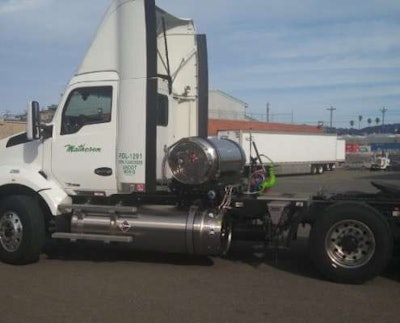 Matheson Trucking reported today it’s added 37 natural gas trucks to its postal delivery fleet.
Matheson Trucking reported today it’s added 37 natural gas trucks to its postal delivery fleet.Matheson Trucking in Sacramento, Calif. announced today that it has added 25 new compressed natural gas (CNG) and 12 liquified natural gas (LNG) tractors to its fleet as part of a company-wide clean energy expansion program designed to improve air quality, lower greenhouse gas emissions (GHGs) and decrease diesel fuel consumption on routes served by the Matheson Postal Services Division.
“With annual fleet distances driven totaling nearly 36 million miles, combining peak and non-peak times, we continue to search for ways to reduce our carbon footprint and GHG emissions to enhance the environment,” says Debra White, vice president of information technology and fleet maintenance for Matheson Trucking. “We’re not doing this just to meet EPA clean air and state emissions standards; it’s the right thing to do.”
Driving 36 million fleet miles is like going around the globe 1,440 times (given earth’s circumference of 25,000 miles at the equator), or making 150 trips to and from the earth to the moon, a distance of 238,855 miles one way.
The company introduced 12 LNG Kenworth T880 day cabs in Oakland, Calif., in January and has completed the deployment of 17 CNG Kenworth T680’s in Boise, Idaho. Matheson is in the process of taking delivery of eight additional CNG T680 sleeper cabs for its Los Angeles to Seattle runs.
The CNG tractors destined for Boise include five, three-axle sleepers; 10, three-axle day cabs, and two, single-axle day cabs. These tractors pull a mix of trailers in Boise, with most in the 53-foot long category, that are used to transport U.S. mail.
Last March and April, Matheson acquired 22 fuel-efficient diesel Kenworth T680 sleepers for use in Seattle, Wash., and is currently deploying 24 additional diesel Kenworth T680 sleepers for use on a variety of the firm’s Salt Lake City routes, for a total of 46 new diesel tractors purchased in 2015.

“We plan to increase our inventory of green CNG tractors in the fleet wherever it is practical and cost effective to do so, and while diesel may still have an edge on long-haul routes, Matheson wants to move in a positive, responsible direction by becoming less dependent on fossil fuel,” explains Joshua Matheson, vice president of operations.
Together these new vehicles bring the company’s tractor fleet total across all divisions to 262, excluding any rental tractors the company has in its nationwide network.
“Matheson is well underway toward achieving its goal of utilizing alternative technology and/or alternative fuels. We are a 98 percent Kenworth shop, with a few Freightliners and International tractors still in the fleet,” says White.
“We partnered with Kenworth, Agility Fuel Systems and Clean Energy Fuels Corporation to spec the most fuel-efficient tractors possible as well as to expand the network of natural gas fueling stations across the U.S. With the introduction of these new CNG and LNG tractors, Matheson estimates this will decrease the company’s diesel fuel consumption by 718,468 gallons per year.”
Matheson’s Sacramento Maintenance Manager Daniel Shandy noted that benefits associated with using CNG fuel include reduced CO2 and other greenhouse gas emissions, with no need for Diesel Oxidation Catalyst (DOC), Diesel Particulate Filter (DPF), or a Selective Catalyst Reductions System (SCR). Matheson’s CNG tractors produce far less air pollution, virtually no smoke from the exhaust, as well as greater ease of maintenance.
“What is really impressive to me is that CNG-powered tractors are incredibly quiet with a decibel level that is really low,” Shandy said.
Jason Criner, Matheson’s Boise shop manager and a certified CNG cylinder and fuel system inspector (CNG-FSI), observed that in the event of an accident with tank damage, gas vaporizes into the atmosphere eliminating the need for an oil spill cleanup and increasing the safety margin for drivers and local communities.
“With a conservative range of 704 miles on a full tank, these CNG tractors are ideal for shorter routes where refueling may not be required for a roundtrip. However, both Boise and Salt Lake are within the range of local fueling companies which makes these regions a great place to start deploying CNG-fueled tractors,” says Criner.
During CNG refueling, heat is generated during the 3,600psi intake process, meaning gas expands requiring up to a 30-minute waiting period until the psi level returns to 3,000psi before the tank can be topped off top with another 15 to 18 gallons. In any business time is money, and saving a half hour or more is important for scheduling and on-time delivery.
Gary Sandquist, Matheson’s terminal manager in Boise supervising a staff of 67 employees, said his business unit has 17 CNG tractors deployed representing 20 percent of the Boise fleet. With shorter runs within his territory, refueling delays are not an obstacle.
Seventeen tractors were assembled in July 2015 at Kenworth’s 300,000 square foot plant in Chillicothe, Ohio, and then shipped to Fontana, Calif., where Agility Fuel Systems outfit them with natural gas tanks, hoses and related apparatus, according to Mike Graft, marketing manager with Agility. It takes only two to three days per tractor to make the CNG conversion. Following a pre-delivery, on-road inspection, these vehicles were ready for commercial use by the end of October.








